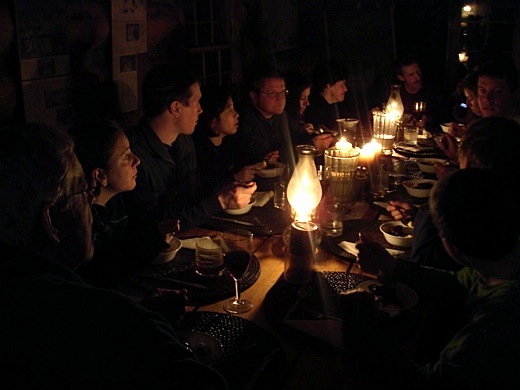 Image above: Dinner in Algonquin cabin. All you need - Food, Drink, Shelter, Community.
From (http://www.voyageurquest.com/blog/2008_03_01_archive.html).
[Publisher's Note: Guy McPherson's Mud Hut is located in the Southwest United States, possibly near Tuscon]
By Guy McPherson on 15 March 2010 in Nature Bats Last -
(http://guymcpherson.com/2010/03/what-works-caveats-for-a-series-of-essays)
My next few essays will concentrate on the cardinal elements of survival: water, food, body temperature, and community. Unless and until we secure these four entities, we will not survive.
Image above: Dinner in Algonquin cabin. All you need - Food, Drink, Shelter, Community.
From (http://www.voyageurquest.com/blog/2008_03_01_archive.html).
[Publisher's Note: Guy McPherson's Mud Hut is located in the Southwest United States, possibly near Tuscon]
By Guy McPherson on 15 March 2010 in Nature Bats Last -
(http://guymcpherson.com/2010/03/what-works-caveats-for-a-series-of-essays)
My next few essays will concentrate on the cardinal elements of survival: water, food, body temperature, and community. Unless and until we secure these four entities, we will not survive. At the mud hut, our goal is not merely survival. We intend to thrive during the post-carbon era. We relish the opportunity to see the living planet make a comeback from the oppression of industry. With thriving in mind, this initial essay lays out the assumptions and caveats associated with the post-carbon living arrangements I will describe in future posts.
In a dose of wishful thinking symptomatic of American society, I will treat clean air as an entitlement that will last forever. Reality suggests otherwise: Nuclear winter, a likely outcome at the endpoint of the ongoing economic collapse, threatens every species on Earth, including the wise humans, Homo sapiens sapiens.
I’ll not be writing about the myth of sustainability, as I’ve done before, choosing instead to focus on durability. Sustainability implies we can sustain, essentially forever. Reality indicates we slip out of the void, take a few blinks, and disappear back into the void. This reality applies at all levels, from individual beings through societies and species. If we’re special, we’re only as special as yeast and cockroaches. Maybe less so. The extremely short existence of the genus Homo should serve as sufficient evidence: Humans have been hanging around about two million years, or about 0.04% of the existence of Earth, a young planet in one of an infinite number of universes.
If that’s not enough evidence for you, briefly consider the Laws of Thermodynamics. They’re laws, not suggestions. The much-detested Second Law really pokes a hole in the notion of sustainability.
Given the transient nature of our existence and the pesky Second Law, I believe we should invest in a durable set of living arrangements, as I’ve indicated previously. It’s clearly too late to secure the elements of survival for 310 million Americans, much less 6.8 billion people on Earth. We are too far into ecological overshoot and too far along the industrial treadmill to keep the current game going or to invest in a more sane set of arrangements. As a result, it seems we’ll keep trundling along the patently unsustainable path of economic growth until we can’t. At that point, the industrial age will end rather abruptly, much to the surprise of industrialist humans, most of whom are selectively deaf to the roar of the runaway train as it screams over the cliff of empire.
Developing a durable set of living arrangements is a site-specific enterprise. In many tropical regions, a person would have a difficult time starving to death because food grows on trees. Securing water is similarly easy, at least in the humid tropics. On the other hand, boreal regions are characterized by short growing seasons, cold weather, and frozen ground (hence frozen water pipes). But there’s plenty of wood for heat.
Between the extremes of the tropics and the tundra, the mud hut still faces environmental challenges at 1,400 m elevation. Water is scarce throughout the deserts of southwestern North America, food is difficult to secure, and maintaining body temperature at 37 C is difficult because the climate is hot, dry, and trending hotter and drier, potentially lethally so. And just when I thought cold weather wouldn’t pose a problem, a water pipe froze eighteen inches belowground. In my next essay, I’ll provide details about that incident, which suggests the importance of getting an early start on creating a new life. It takes a while to figure out the seasons, and the neighbors.
If we can make it work here, I’m fairly certain you can make it work in just about any rural area. I don’t think cities have much of a chance in our near-term future — inhabitants of the apex of empire will suffer mightily when the empire completes its fall — but small communities might serve as lifeboats through economic collapse and global climate change.
Here at the mud hut, we have developed a comprehensive set of living arrangements focused on the cardinal four elements of survival within a warm-temperate region of the southwestern United States. Summer high temperatures exceed 40 C every year, and winter brings low temperatures below -10 C for several weeks. Diurnal temperature swings routinely exceed 25 C. Soils are cobbly, well-drained, unsorted alluvium in serious need of organic matter. Water is shallow — less than 10 meters below the soil surface — because we live with one-half mile of a perennial river. The human community is eclectic, but generally tolerant and perhaps even accepting of alternative lifestyles.
.
No comments :
Post a Comment